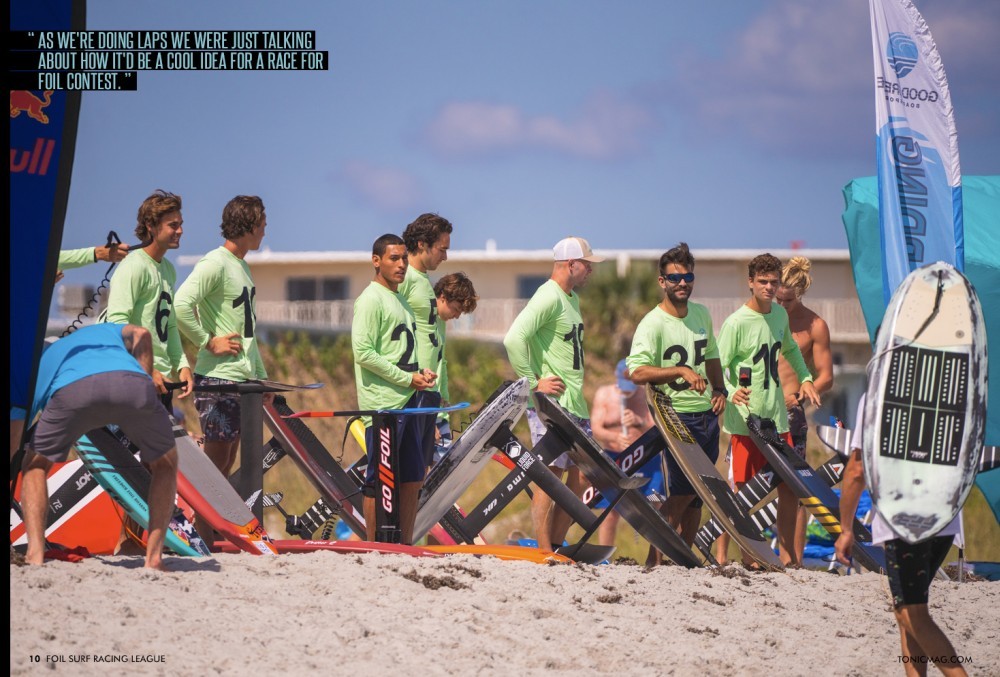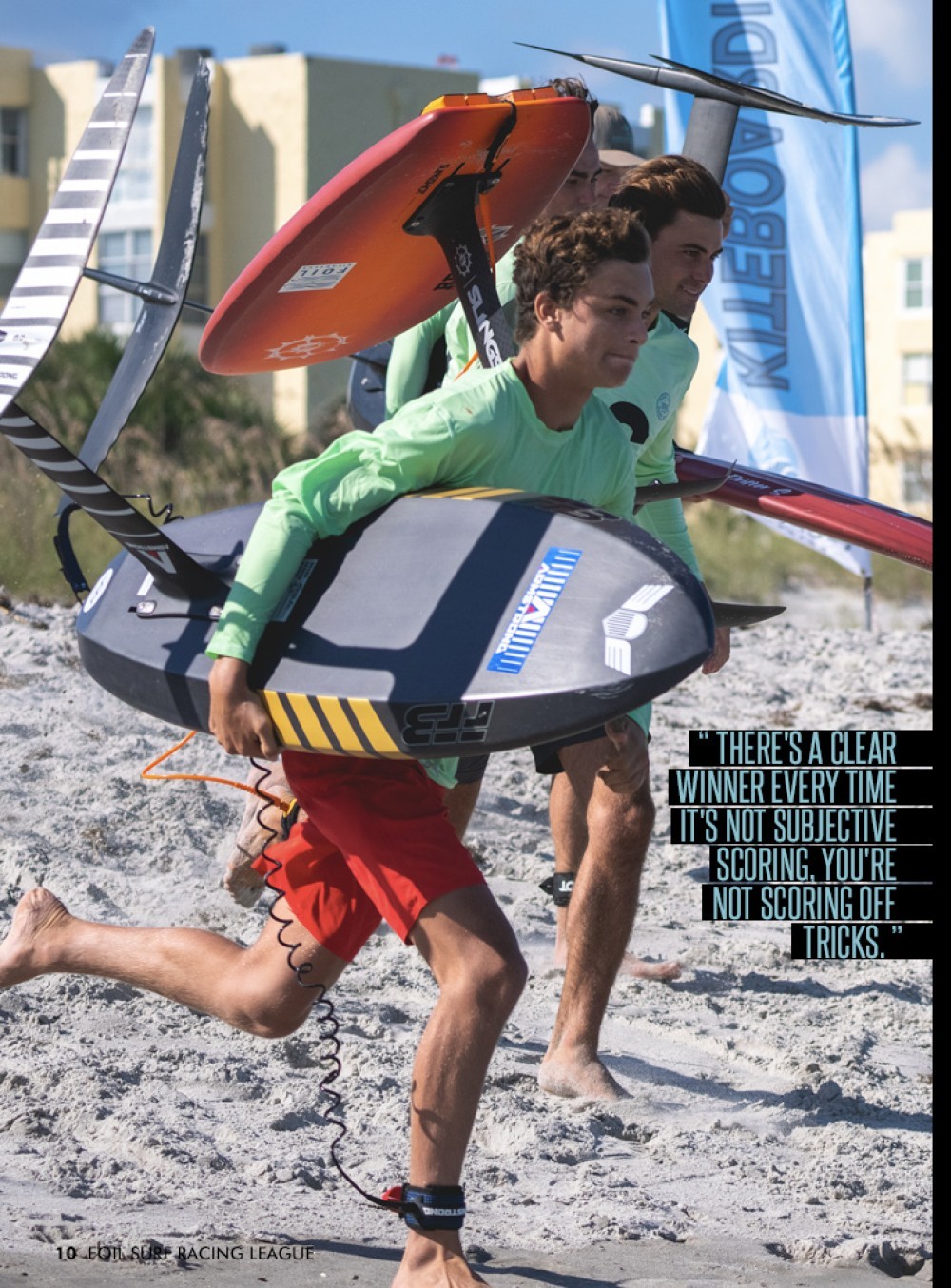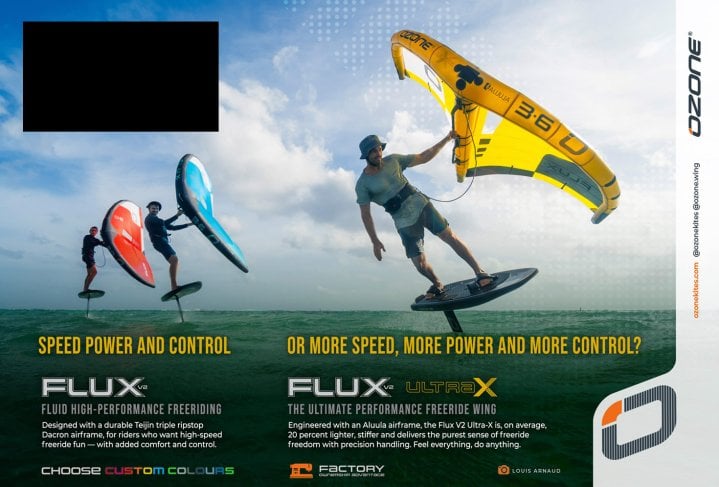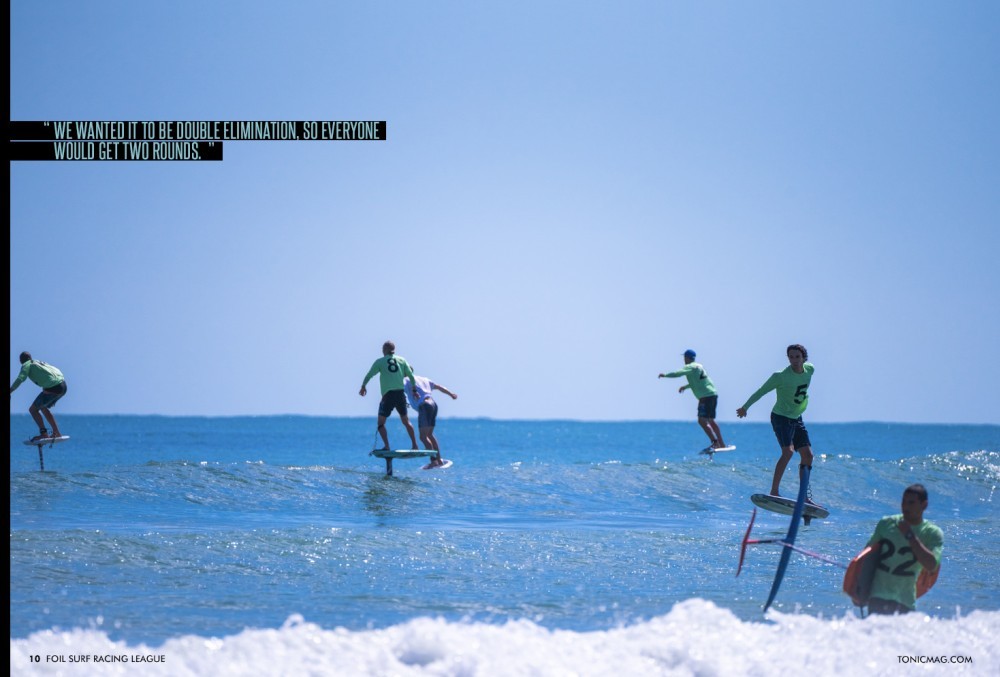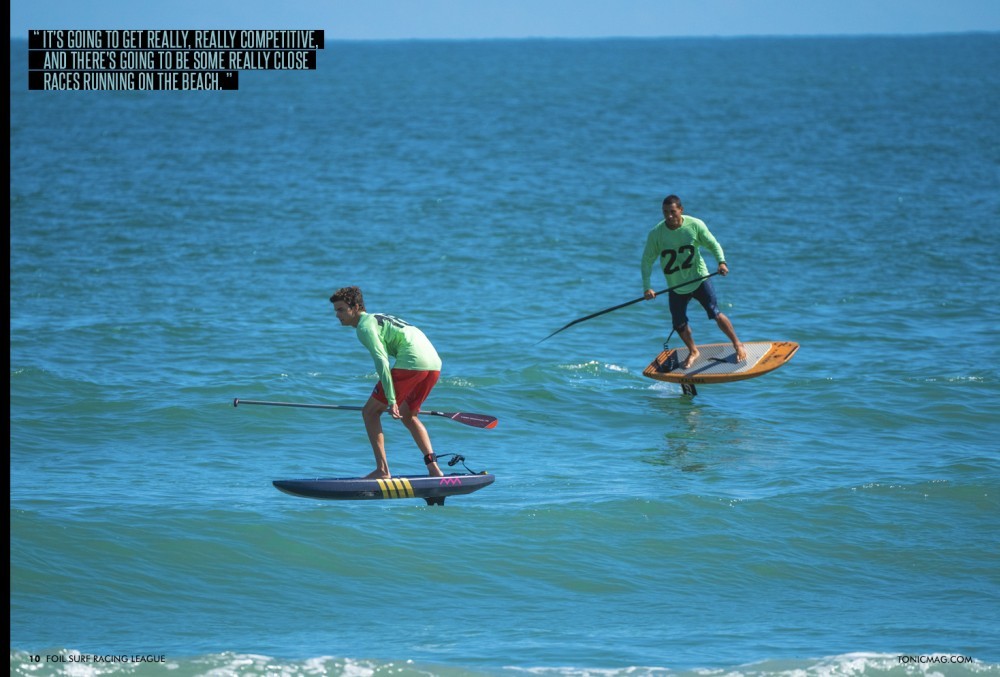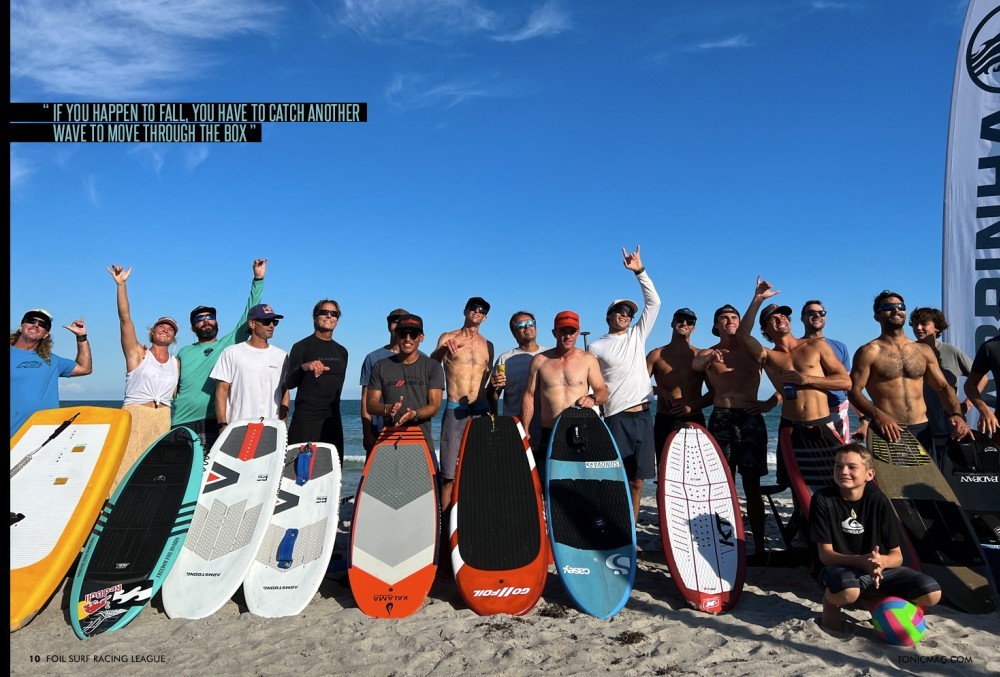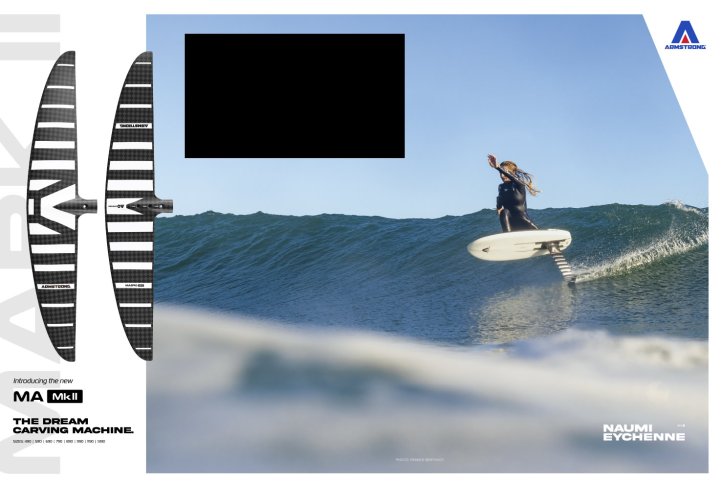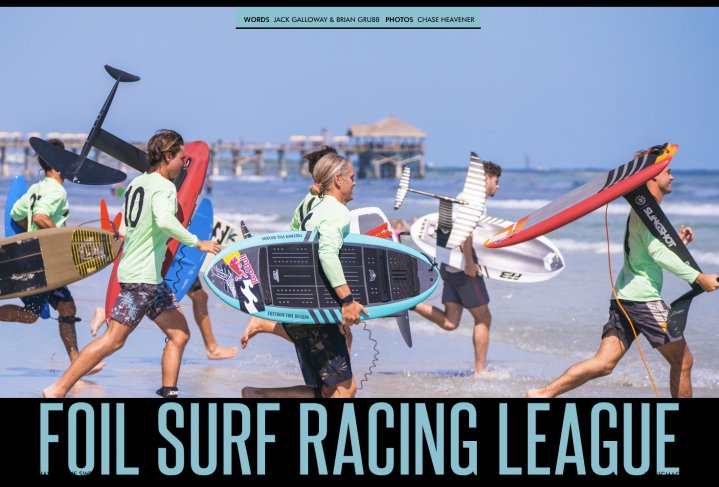
Foil Surf Racing League
Issue 10 / Wed 17th Nov, 2021
We chat to Brian Grubb, founder of the Foil Surf Racing League, a unique & exciting event that recently took place in Cocoa Beach, Florida
We’re super excited to have Brian Grubb join us, creator of the Foil Surf Racing League. This brand new and unique style of racing has caught the attention of foilers worldwide. At the gun, competitors run down the beach into the break, they then catch a wave and enter the ‘Action Box’ which they can only do once on foil. They travel as quick as they can to cross the line at the end of the Action Box and then run along the beach or pump their way back. First rider to do two laps wins! Read on to find out all about this eye catching event in Cocoa Beach, Florida.
Hi Brian. Thanks for joining us. The event looked brilliant. How did it go?
Thanks, man. Yeah, it was really good. It was our second event. We did our first one back in March of 2020. Right when COVID was starting, so we tried to build up some momentum there. And then, you know, had to hit the brakes for a while. But yeah, we're happy to do it again this year. We changed the format a little bit and had a great turnout. We also had pretty good conditions for the event so couldn't really ask for anything more.
Awesome. It’s such a unique idea. How did you come up with the format?
I was going down to Puerto Rico and hanging out with Nick Leason from Lift Foils. And there's a wave by his house that's a right-hand point break. We were doing laps, you get in, foil around the point and you get out and run back up to the beach. As we're doing laps we were just talking about how it'd be a cool idea for a race for foil contest. So yeah, I just kind of took it from there. That’s when I talked with Red Bull a little bit and then partnered with my buddy Billy that runs the Foil Outlet store here in Cocoa Beach.
It looks like you had a great atmosphere at the event with everyone sharing the stoke?
Yeah, and that's something that we wanted to do at this event is do those bigger heats. Last time around we were doing just six-man heats. And, it was cool, but we were thinking if we do bigger heats there's more action in the water and there's more strategy involved.
One of the cool things I like about the racing is that there's a clear winner every time it's not subjective scoring, you're not scoring off tricks. So you can kind of play up to your strengths as a foiler. Getting a quick takeoff early in the heat definitely helps. But if you're a faster runner, you can hit the beach on your way back upstream, and you can try to run back that way. There's a lot of different ways that you can do the race, and everyone can kind of adapt to it. I come from a wakeskate background, that's all subjective scoring, doing tricks behind the boat and stuff so to be able to have a format like this, there's a clear winner, there's a race and there is a ton of strategy, and it's a real high endurance sport.
What was the format of the competition in terms of heats & elimination? And how did you decide how long the ‘action box’ would be?
The course ended up being 225 yards long, we might change it depending on the conditions in the future but that seemed like a pretty good length for the course to be able to go down and back and we got really lucky. We didn't have a lot of wind that day.
Despite the good conditions, we did get low tide right in the middle of the day, you’ll see in the video that you see guys hitting the bottom and jacking off. Even Austin, who ended up winning the event, switched down to like a 24-inch mast just so he could like take off even in shallower water.
With the format we wanted it to be double elimination, so everyone would get two rounds. We had 25 guys in the first race so that basically ranked everyone from 1 to 25 just based on how they finished in that first race. From there we did heats and just seeded everyone from their results from that 25 man heat. In the quarterfinals, we took the top four out to go straight to the semi-finals. And then we took the other nine guys and did a last chance qualifier. So we took four out of that. So that got us down to 20 people for the semi-final, the first 10 to finish that went straight to the final. So we did big heats. But everyone got to ride at least twice. And if you didn't do well, in that first quarterfinal round, you had that last chance qualifier that you could retry. That actually happened for Austin, he won the first race and came all the way from Hawaii for this event and he actually had to ride the qualifier just to get into the final two! Wow. He ended up winning the event! So you can have a bad heat in the quarters and, you know, still get through the last chance qualifiers and win the event. That's pretty cool.
It must put so much pressure on the riders in that final. The fact that the winner of that race wins the event. No mistakes allowed, you can't just breach your foil. Must make it exciting to watch?
Yeah, definitely. Yeah, I was having a pretty good day out there, too. I got through the semis feeling pretty good. And then in the final, I tried to take off on the first wave and missed it! Then everyone else kind of took off. I ended up ninth. So, yeah, even if you’re the best guy out there, if you make a mistake, it can come back to get you. So there are definitely lots of guys that could win the event. I think once we keep running these events next year, and we get more people involved, it's going to get really, really competitive, and there's going to be some really close races running on the beach.
We’d love an event like this in the UK. I presume you managed to close the beach in some way?
We got a permit from the city of Cocoa Beach. So we had an area kind of blocked off. Now we're doing our next race in conjunction with the Beach and Boards Fest, which is like a big city-wide festival in Cocoa Beach in March. Registration is open already on our website and Instagram page. The beach will be a lot more crowded than it was this time, so we'll have lifeguards helping us out.
Did you have any racing rules?
We call that 225 yard area the Action Box. Basically like an upstream and downstream boundary. So we do a beach star, everyone runs into the water, you got to stay outside the Action Box until you get up on foil. But once you're up on foil, you can cross the first line and get inside the action box from there. As you start working your way down. If you happen to fall, you have to catch another wave to move through the box. So to do well you just have to stay on foil.
On the way back it is a little bit different. We have a buoy out in the water and then a flag on the beach, that makes the boundary line. So as soon as you get that green flag, you can basically either turn back and try to foil your way back or you can hit the beach and run back. We do two-lap races. On the way back upstream, if you do come off foil you have to go straight into the beach and run back from there. So you're penalised on the way back, if you do happen to fall, like when your legs are getting tired.
So yeah, there's some strategy involved, if you're getting tired, you kind of want to work your way back towards the beach, because if you come off, well, you're gonna have to hit the beach anyways. But if you can make it back, for your second lap, you do have to come off foil and catch another wave for your second lap too. So we can't go into your second lap without having to stop in between. We did that because the takeoff is kind of the most critical part of the race, so we want to make sure that it had to be done at least twice.
We don't have any restrictions on wing sizes, or boards, or any kind of equipment stuff right now. So people can, you know, pretty much ride what they want. Most people are on High Aspect wings. You're not allowed to make contact with anybody. We had a riders meeting before the event asking the riders to be competitive but keep it clean!
In the video one of the finishes between Mateo & Austin was super close, was that for the final race, or was that one of the ones before?
The closest race was the SUP race, I think it was a semi-final Mateo and Austin, they were running at the beach, like, a few steps apart from each other. And you have to carry your board, paddle, and leash. Yeah, it was pretty awesome to see. Across the event, there was some really close racing on the water.
Sounds great to watch. I'm hoping it just continues to build for you and gets a bit more traction. Is there a minimum swell that you'd want the waves to be to run the race?
The conditions definitely come into play. We had a two-day window, just in case. We ran the race on Saturday in great conditions and actually on Sunday, we had a bunch of wind come in, and the takeoffs were super tough. On the inside, it was even shallower. It was like a 15 to 20 mile an hour north wind on it, too. So we're really happy with the conditions we got for this race. With a bigger swell, I think it'd be pretty exciting. But yeah, anything less than what we ran would be tricky.
We plan to try to do three or four of them next year, try and do one on the West Coast in California and maybe do some up the East Coast over here, like up in North Carolina. We’ll see if we can get some more sponsors to get involved and increase the prize money to get more people to come. If the prize money is better people will travel for it. Austin and Mateo came from Hawaii, we had some guys come down from New Jersey and Texas. And, you know, we only had about a $2,000 purse for this event. So yeah, we're really happy with the turnout and the support that we got from everyone that came to this one. I think we can get maybe 40 or 50 people at the next event and make it a really cool event for foilers.
Awesome. Well thanks so much for taking the time, we’re super excited to see footage from the next one!
Thanks so much. Nice to meet you.
Videos
By Jack Galloway




